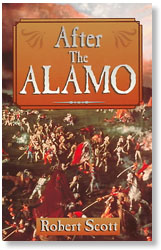![]()

After the Alamo
by Robert Scott
![]()
Republic of Texas Press, 2000.
Softcover, 310 pages
maps, and illustrations, chapter notes, bibliography, index.
SRP $18.95.
![]()
Robert Scott's premise, in After the Alamo, is that after the Texian defeat at the Alamo, "one was saddened, but almost no one was moved to action. . . It was only after the massacre at Goliad that the world came to understand at last that this was not a Mexican government war against freedom fighters - it was vicious genocide." Scott's contention is that most of the men fighting against the Mexican government were not native Texians, but adventurers and troublemakers from the United States, and most native Texians wanted no part in a war they did not consider their own. It was not until After the Alamo, when the massacres of the captured revolutionaries at Goliad showed that General Antonio Lopez de Santa Anna would not be satisfied until all Anglo settlers were driven from Texas, that the Texian settlers rallied to combat the invading Mexican Army. In effect, the Goliad massacre removed any chance of a peaceful settlement of the revolution. The Anglo colonists were left with three choices: flee Texas permanently, fight for their freedom, or die.
After the Alamo tells the history of the Texas Revolution, with major emphasis on the ill-fated Matamoros expedition, the personality of James Walker Fannin, the Battle of Coleto Creek, and the Goliad Massacre. Scott employs a lot of quotations from the people who were at the scene, which are always interesting. Even though I don't necessarily agree with his basic premise, he does a creditable job of presenting his hypothesis. I have no problem with his opinions, but I do have a real problem with Scott's many factual errors. This book is just not good history.
Scott shows little sense of period. For example, among the defenders of the Gonzales 'Come and Take It' cannon, are cowboys. At the Battle of Coleto Creek, he has mountain men. To this reviewer, this conjures up images of men like Charlie Siringo and Jim Bridger, instead of the farmers, Texano ranchers, shopkeepers, blacksmiths, lawyers, and amateur soldiers who actually composed the Texian Army.
There is a lot of erroneous information in After the Alamo. For instance, at the first battle of the Alamo, in early December of 1835, we find William Barret Travis and James Bowie accompanying Ben Milam in his assault on Bexar and the Alamo. Unfortunately, neither Travis nor Bowie was with the Texian army surrounding Bexar at that time, and the Texians did not attack the Alamo.
In early February 1836, when Santa Anna's army crossed the Rio Grande, we learn that "hundreds of Americans living on ranches in deep south Texas began racing northward in panic just ahead of the approaching Mexican army." This is especially interesting, because the Anglo settlements were to the northeast, far from the Rio Grande.
We are told that on 11 February, "Colonel William Travis arrived at Bexar, under orders from General Sam Houston to relieve Colonel Neill as Texas' commander at the Alamo. To his dismay, Travis learned that Jim Bowie, who had been hanging around the Alamo in anticipation of a fight, had grown bored with the lack of action there. Neill warned Travis that Bowie - somehow unaware of the approaching Mexican army - planned to leave the Alamo the following day and was going to take with him all of his followers." This brand new information is going to amaze other Texas historians who have been thinking Neill left Bexar on an unplanned temporary leave of absence due to a family illness, and that Bowie, instead of just hanging around, was ordered to the Alamo to assess the situation there for Sam Houston. I join Robert Scott in wondering how Bowie was unaware of the approach of the Mexicans - I would have thought at least a few of the hundreds of fleeing American ranchers would have stopped by Bexar.
Scott's description of the fall of the Alamo is exceptionally enlightening. Instead of taking place in the pre-dawn darkness, the assault started at 8:00 A.M. The Mexicans used Mayan Indians as shock troops, marching them shoulder-to-shoulder on a "death march toward the fort." Famed mountain man, Joseph R. Walker, must have led some of his friends through a time portal to come to the aid of his brother, Jacob, who was one of the defenders — we learn that line after line of attackers were mowed down by the "mountain men." "When one line of attackers would disappear under the withering gunfire from the Alamo, other soldiers immediately took their place and continued the march toward the fortress." I know the Mexican soldados were brave, but this sounds absolutely suicidal.
In the midst of this exciting action, and terrible slaughter of the poor Mayan forlorn hope, "Santa Anna's cannons were pounding the Alamo. Eventually a chance shot achieved what two weeks of steady shelling had failed earlier to accomplish. The lucky cannon ball knocked down a huge chunk of the Alamo's outer wall. Almost instantly Mexican soldiers were there, laying ladders against the rubble. In seconds those Mayan warriors leading the assault were clawing their way up the ladders and over the debris." This is all great stuff, but there is no basis in fact for any of it.
I've always thought there was no book about the Texas Revolution I didn't like, but I can no longer say that. The only reason to buy this book is to play a rousing game of "spot the historical blunders." I think Robert Scott has some good theories, although they are not earth shattering, but either he or the Republic of Texas Press should have submitted After the Alamo to some historians for editing. There are far too many factual errors to make this volume a worthwhile addition to the field of Texas history.
Robert L. Durham, Books Editor
Alamo de Parras
05/00
![]()